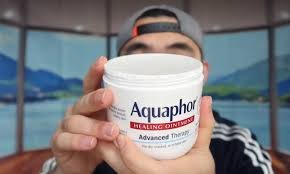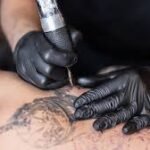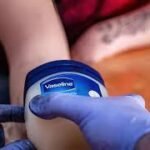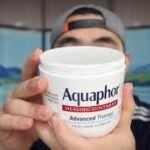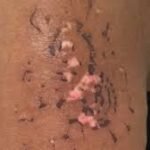Getting a fresh tattoo is exciting, but the real work begins after you leave the studio. Your skin is traumatized, and that vibrant ink is essentially an open wound for the first few weeks. Proper care is crucial to heal properly and show off your new art without issues.
Many artists and enthusiasts recommend Aquaphor as a go-to aftercare product—it’s affordable, accessible, and commonly used. But is it really the best option? While it works well for some people, others find it too heavy, leading to clogged pores. Doctors and professionals often suggest lighter alternatives that still keep the tattoo protected and moisturized without suffocating the skin. The debate continues, but one thing’s unanimous: your healing process needs help, so choose wisely.
With so many opinions and recommendations, it’s hard to know who to trust. Some swear by Aquaphor, while others disqualify it entirely. The truth? There’s no one-size-fits-all solution. Your new tattoo’s needs depend on your skin, aftercare routine, and even climate. HUSH simplifies things—offering better, science-backed alternatives that provide the right balance of protection and breathability.
What Is Aquaphor?
Aquaphor is a highly effective, multi-purpose healing ointment that comes in packaging similar to a toothpaste tube. Its primary ingredients – 41% petroleum jelly, mineral oil, glycerin, and lanolin alcohol – work together to hydrate, protect, and heal damaged skin. While it might seem weird that petrolatum (a refined byproduct of petroleum) is safe for use on tattoos, dermatologists have recognized its benefits for minor wounds for years.
What makes Aquaphor particularly useful for new tattoos is how it lets air in while forming a protective barrier. The blended formula contains skin-conditioning agents like panthenol that moisturize and help heal the dry, traumatized skin under your fresh ink. However, heads up to vegans: since it contains sheep’s wool-derived lanolin, this isn’t a vegan product. If that’s you, you may want to skip to other tattoo care products.
-
Petroleum jelly
Petrolatum, the primary ingredient derived from crude oil, forms a thin, water-repellant barrier that protects wounded skin by locking moisture in while keeping bacteria out, promoting your skin’s natural healing process as it softens into a topical gel through careful refining.
-
Glycerin
Ever wonder how Aquaphor keeps fresh ink hydrated without clogging pores? The magic lies in glycerin—a humectant derived from fats (yes, like that Fight Club scene where they turn fat into soap). This ingredient attracts and retains moisture, complimenting the strength of petrolatum while keeping your tattoo’s healing chemical reaction in check.
-
Panthenol
Panthenol (a derivative of B complex vitamins) works at a topical level to promote positive reactions—it soothes, regenerates, and improves skin elasticity while reducing inflammation and supporting wound healing. As a tattoo artist, I’ve seen how this anti-inflammatory ingredient acts as both a protector and moisturizer, thanks to its properties as provitamin B5.
-
Lanolin alcohol
This key ingredient works wonders by softening and smoothing your healing skin, accelerating cell regeneration while reducing the possibility of ugly scarring – I’ve seen it transform angry new tattoos into healed masterpieces faster than you’d believe.
What Does Aquaphor Do?
When you slather on Aquaphor, its thick formula creates a barrier that seals in moisture while locking out bacteria – I’ve seen how this protectant works wonders on raw tattooed skin, whether it’s relieving discomfort from minor cuts, soothing burned or blistered areas, or helping wound heal faster. Unlike thinner products, it protects sensitive new ink from shock like cold temperatures and wind, while preventing dry, cracked skin and damage from the environment – which is why we also use it on dried heels, ankles, hands and lips during harsh weather.
Is Aquaphor Good for Tattoos?
While many tattoo artists routinely recommend Aquaphor as a staple in tattoo aftercare, there’s growing speculation about whether this petrolatum-based product truly meets all the needs of healing skin. Yes, it’s cheap, easily accessible, and designed to create a protective barrier that keeps out bacteria while locking in moisture – it certainly gets the job done for most people. But after years in the industry, I’ve noticed that while it may prevent complications in the healing process, some clients experience subtle ink loss that impacts their tattoo’s final appearance.
The concern lies in how petrolatum and mineral oil might bind with ink in a fresh tattoo, potentially pulling small amounts out as the body naturally expels plasma fluid from the wound. While it’s normal to lose a small amount of ink during healing (this drains away with plasma and usually doesn’t cause a problem), combining this natural process with Aquaphor’s minor ink-pulling capacity could cause premature fading. That said, there’s no official study proving how much ink Aquaphor might remove, and many artists claim they’ve never experienced significant ink loss – so take this with a grain of salt.
What Is Aquaphor Used For?
Aquaphor has earned its spot as a popular skincare ointment, doctors recommend it for everything from dry, cracked skin to minor cuts, burns, and even eczema. It’s an excellent healing solution for chapped lips, rough elbows, and constantly dry hands and heels—thanks to its ability to hydrate and create a protective barrier. This common ointment (the cousin of Vaseline) shines in post-operative wound care, diaper rash treatment, and calming general skin irritations because of its healing properties that help heal wounds and treat conditions effectively.
But here’s the rub: while recently many people have turned to Aquaphor as a tattoo aftercare solution, what makes it effective for healing dry and wounded skin is exactly why it’s ineffective for healing tattoos. Fresh ink needs to breathe and heal differently than typical skin wounds—something I’ve learned the hard way after seeing clients struggle with clogged pores and slow healing when using traditional ointments on their fresh tattoos.
What Does Skin Need To Heal?
Your body works hard to heal tattooed skin, but those open wounds remain vulnerable to infection without proper help – I’ve seen too many clients end up with dry, scabby tattoos that lose ink and definition when they ignore their skin’s begging for intervention. Tattoo aftercare is actually simple and comes down to a few things: preventing dehydrated, flaky skin that feels uncomfortable while giving your skin exactly what it needs to recover properly.
Moisture
Fresh tattoos are essentially wounds, and their healing depends heavily on moisture—but not just any kind. Too much water (like long shower exposure) can slow recovery, while dehydration cracks the skin, delaying closure. The key is a protective barrier that locks in natural moisture without suffocating the wound.
This is where ingredients like glycerin and naturally derived oils shine. They’re heavy enough to sit on the skin, forming a seal that prevents escaping hydration while keeping out bacteria. After I cleaned my tattoo, I used a moisturizer with these elements—applied 3-5 times per day—and noticed faster, healthy healing. The cellular regeneration was visibly stimulated, unlike when I’d skipped moisturizing and dealt with scabbing.
Aquaphor (or Ink Balm) works similarly. Its protective moisture barrier mimics the body’s natural healing processes, but don’t overdo it—once or twice daily is plenty. A freshly sanitized tattoo needs balance: hydrate, but let the area breathe. Too much product absorbs poorly, risking clogged pores. When done right, the effect is the opposite of complicated: smooth, vibrant ink.
Antimicrobial and Antibacterial Ingredients
A new tattoo is essentially an open wound, making your skin temporarily broken and vulnerable to infection. While it’s tempting to reach for harsh solutions like rubbing alcohol or peroxide, these can actually wreck your healing skin by destroying its natural repair process. Instead, opt for gentle antimicrobial ingredients that keep germs in check without damaging your ink.
I’ve learned through experience that natural compounds like bisabolol (a derivative of German chamomile flower) work wonders. This powerful antibacterial agent has microbe-fighting abilities while being soothing to the body – the perfect combo for tattoo aftercare. Remember, hygiene is a big deal when dealing with bacteria and microbes that could cause serious problems if they spread to other parts of your body. The right properties in your aftercare products can mean the difference between a healed masterpiece and a problem you’ll regret.
Vitamins
Your fresh tattoo is essentially damaged tissue, and your body works hard to repair it. Collagen, the protein that acts as one of the main building blocks of skin, plays a huge role in this process. To support healing, you need key vitamins—Vitamin C helps with growth and repair, while Vitamin A stimulates fresh healthy skin cells. I’ve found that clients who eat a balanced diet or use a multivitamin tend to see faster recovery.
Don’t overlook topical care—Panthenol (vitamin B12) isn’t just for healthy red blood cells; when applied topically, it conditions and fortifies the skin, speeding up heal time. I always recommend a mix of ingesting nutrients and topically treating the area—your muscles, tendons, and hair (if nearby) benefit too. Think of it as fuel for your body’s hard work—because healing a tattoo is a job that demands the right resources.
Healthy Fats
After years of working with healing tattoos, I’ve seen how naturally-derived oils like argan oil and sweet almond oil truly serve their purpose – they deeply hydrate and nourish healing skin while helping lock in crucial moisture. These healthy fats don’t just improve skin texture; when you regularly use them to moisturize your tattoo, that deep quenching nourishment makes the colors appear more vibrant over time. It’s not magic – quality oils work at the cellular level to support your ink’s longevity.
Cleaning
Let me be blunt – I’ve seen too many beautiful ink jobs get ruined because people skip the basics. Cleaning your fresh tattoo properly isn’t optional; it’s survival. You need to clean that area at least twice per day to rid it of invisible threats like germs, bacteria, and other possible infect ants. This isn’t just about aftercare – it’s about preventing your skin from becoming infected and suffering permanently damage. Trust me, no amount of Aquaphor can fix what neglect destroys.
Protection
While cleaning and moisturizing are crucial, you’ll need to protect that fresh area like it’s your job. The sun is public enemy #1 – and don’t even think about bodies of water like pools, lakes, or oceans for at least 3-4 weeks. When working out, watch out for sweat buildup and opt for loose-fitting clothing to prevent overheating and rubbing. I tell all my clients to stay mindful when moving around or making plans – your healing skin deserves VIP treatment.
Patience
Here’s the hard truth – while modern tattoos heal faster than ever, your ink still needs time (typically 2-3 weeks) depending on its size, location, and your skin’s sensitivity. I’ve watched clients rush the process only to ruin great work – your tattoo aftercare is up to you, but decide wisely. Clean, moisturize, and protect your skin on a regular basis if you want it to heal quickly and last forever. While Aquaphor works, there are better options – but nothing beats patience. Wait until it’s truly ready before you show off to friends; good aftercare means never having to say “my tattoo looked better before…”
Aquaphor alternatives
Vaseline
Let me save you some trouble – while Vaseline (that petroleum jelly staple) might seem like a quick fix, it’s absolutely not a suitable alternative for a healthy tattoo aftercare routine. Like Aquaphor, it traps everything – including moisture and bacteria – creating the perfect storm for infections and ugly scarring. After seeing one too many ruined tattoos, I can’t stress enough: what works for chapped lips doesn’t work for fresh ink.
Ink Balm
After years of testing products, I’ve found Numbed Ink’s Ink Balm stands apart with its all-natural, organic ingredients blend. Packed with skin-healing vitamins, lipids, and antioxidants, it actively protects and heals your tattoo through every stage of the process. Unlike Aquaphor or Vaseline, this formula allows your skin to breathe while helping retain moisture, all while effectively keeping out bacteria and other infect ants – something petroleum-based products simply can’t match.
Fragrance-free lotion
In tattoo aftercare, simple often works better – if Ink Balm isn’t your style, I always recommend a plain white, fragrance-free lotion with organic ingredients. Here’s why: those artificial colors, scents, and chemical ingredients in regular lotions can seriously irritate your skin, delaying the entire healing process. After healing thousands of tattoos, I’ve learned it’s worth the effort to find the purest option available – your fresh ink will thank you.
What Should I Use Instead of Aquaphor?
When healing tattoos, you need products that do more than just protect – they should actively help heal while keeping your skin healthier than before you got inked. That’s where options like Mad Rabbit’s tattoo soothing gel shine, as they’re specially formulated with active botanicals, skin-healthy oils, and vitamins that work to soothe, restore, and nourishes your fresh, raw skin. Unlike basic ointments, these alternatives contain a wide array of beneficial ingredients that allow proper airflow to prevent suffocating your healing wound, while still protecting against irritation.
After years in the industry, I’ve seen how the right aftercare can make all the difference in how your tattoo heals perfectly. Products designed for tattoos, microblading, and even skin peels or post-waxing skin-soothing treatment address all aspects of healing – they don’t just create a barrier, but actively leave your skin in better condition. The goal isn’t just to get through the healing process, but to emerge with vibrant, healthy-looking ink that lasts.
Does Aquaphor Cause Fading in Tattoos?
Let’s clear up these rumors – Aquaphor doesn’t actually makes tattoos fade when used properly. From my experiences and countless others, this claim simply isn’t true. If your tattoo was done correctly and the ink is where it needs to be, the right ointment should only help your tattoo heal correctly. That said, if your tattoo seems to be fading, the reason likely lies in how it was done properly (or wasn’t) rather than your aftercare choice. I’ve wrote about the million reasons tattoos might appear faded – always check your facts before blaming the products.
Do Other Ointments Work Better Than Aquaphor?
Let’s cut through the noise: while Aquaphor works, study after study shows most people prefer more natural options for their tattoos. Yes, petroleum jelly is technically safe when refined to high-quality standards (despite what fear-mongering articles claim – unless you’re eating gobs of it or using petrol on wounds). But why settle for a regular ointment when options like our Sana Sana CBD healing balm exist? This all-natural blend of botanicals and cannabinoids doesn’t just protect and moisturize your freshie – its 500 mg CBD actively calms skin while helping your ink heal perfectly.
What makes it the bomb? Unlike basic ointments, Sana Sana continues working on healed tattoos to keep colors vibrant and prevent fading. After years in the industry, I’ve seen how these benefits outperform traditional options – they’re better because they work with your body’s natural healing process rather than just creating a barrier. The results speak for themselves: happier skin, brighter tattoos, and zero chemicals to scare you.
Are Aquaphor and Vaseline the Same?
While both contain petroleum jelly, they’re wildly different – Vaseline is a singular ingredient at 100% potency (great for dry skin but terrible for fresh ink as it suffocates wounds by trapping moisture and bad bacteria), while Aquaphor’s smarter 41% multi-ingredient formula actually protects while allowing breathability for proper wound-healing. After seeing countless clients make this mistake, I always recommend choosing Aquaphor for fresh work (or better yet, higher caliber options like Sana Sana or HUSH’s skincare) since its barrier properties keep tattoos moisturized without risking infection – save the Vaseline for healed areas that just need basic care.
When To Switch From Aquaphor to Lotion?
Your tattoo artist will send you home with a bandage covering your fresh ink, telling you to keep it on for 24 hours before gently washing and applying a healing ointment like Aquaphor. This moisturized protection helps those deeper wounds begin to heal, but here’s what many don’t realize: you’ll know it’s the right time to stop the ointment and switch to a regular lotion when your skin starts peeling and feeling itchy – usually around 1 to 2 weeks. At this stage, the irritated top skin just needs lightweight hydration since the real healing work underneath has closed.
Don’t stress about being exact – using ointment a bit longer won’t hurt, though it might feel unnecessarily greasy. That’s why I love Sana Sana, a 2-in-1 product that works on both fresh tattoos and healed skin. Whatever you choose, make sure you’re using thin layers – whether it’s ointment, lotion, or that magic Sana Sana bottle – because suffocating your tattoo is the real enemy.
In Conclusion: Take Care of Your Tattoo
I’ve seen too many clients spend good money on incredible tattoos only to ruin them with crappy job aftercare – within few weeks, that beautiful art turns to garbage, leaving everyone upset. Your tattoo artist puts heart into their work, and neglecting proper care feels like you’ve vandalized their masterpiece. The moral of this story? Choose right products from day one. While Aquaphor is a good cheap option for fresh tattoos, premium alternatives like Mad Rabbit’s Tattoo Aftercare Starter Pack or Sana Sana offer much better, natural formulas that truly protect and nourish your investment.
The secret lies in your routine: gently cleanse with antibacterial foam soap, apply thin layers of protective ointments (never enough to suffocate), then switch to tattoo balm once healed. That kit contains everything you need – from soothing gel for angry new ink to broad spectrum SPF 30 tattoo sunscreen to shield against sun’s harmful UV rays. Skip this, and you’re basically throwing away all that time and money for nothing.
Having worked in studios for years, I’ve witnessed how proper aftercare makes all the difference in how your tattoo turns out. Those who cut corners often return with faded, blurred designs, while clients who use powerful options like plant-based hypoallergenic ointments enjoy vibrant, crisp results. Remember: your skin isn’t fully healed just because it’s no longer peeling – keep moisturizing and protecting until your artist gives the all-clear.
FAQS
Can you put Aquaphor on a fresh tattoo?
Here’s the deal – Aquaphor might be good for fully healed tattoos, but it’s trouble for fresh tattoos. It clogs your skin with no room to breathe, often leaving patchy results. After seeing hundreds of healing tattoos, I always tell clients to stick with Lubriderm instead – apply a normal amount (don’t go heavy handed) and reapply only when your skin feels dry or itchy. Trust me, your tattoo will thank you for giving it space to heal properly.
Why do tattoo artists say not to use Aquaphor?
Most tattoo artists strongly advise against using Aquaphor on new tattoos, and here’s why: this petroleum-based product creates a thick, protective barrier that actually prevents air and oxygen from reaching your fresh ink. While it might seem helpful, this airtight barrier reduces oxygen flow – something crucial for proper healing when your skin needs to breathe and receive oxygen to heal properly. I’ve seen cases where this hinders the healing so much that it pushes ink away from the skin, leading to premature fading before the tattoo even settles properly.
The problems don’t stop there. That same barrier that traps moisture also traps bacteria, potentially leading to infection and significantly delaying the healing process. The petrolatum in Aquaphor may even bind with your ink and potentially pull it from your skin, according to many experts – hence the term “Ink Fading”. While it can act as a barrier against bacteria, it ironically creates an environment conducive to bacterial growth, raising your Infection Risk substantially.
That said, some artists might recommend Aquaphor for a short period in certain climates, or some individuals may use it for the first few days to help keep the area moist and comfortable during the initial healing phase. But most prefer to switch to unscented lotions or specialized tattoo aftercare products for the rest of the healing journey. When it comes to long-term aftercare, Aquaphor simply isn’t the preferred choice due to all these potential issues.
What is the best ointment for tattoos?
For optimal healing, apply a thin layer of antibiotic ointment like Bacitracin™ Zinc Oxide ointment, Neosporin™, or Vitamin A&D ointment right after getting inked. After 5 days, make the switch to a gentle, fragrance-free, color-free body lotion. Here’s the key – repeat this washing and ointment procedure at least 3 times a day consistently for 1–2 weeks. This routine keeps your tattoo protected without suffocating it, something I’ve found works better than petroleum-based products in my years of experience.
What is the best healing ointment for tattoos?
When it comes to ointment options for fresh ink, recommendations vary widely across the market – from petroleum-based picks like Vaseline and Aquaphor, to natural oils and butters, and even unexpected choices like diaper rash creams. More recently, we’re seeing products geared specifically toward optimal tattoo healing, each with their own pros and cons that I’ve tested extensively in my studio.
